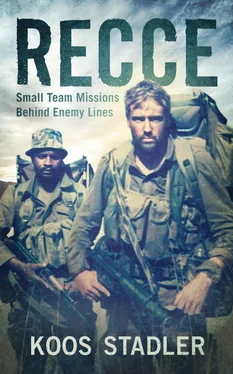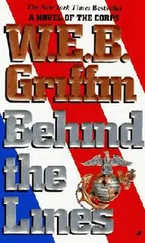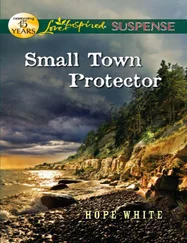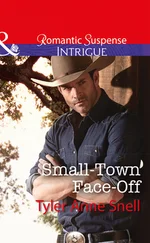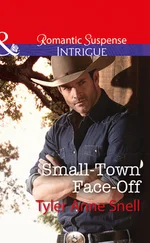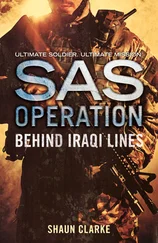I soon slipped off my boots and anti-tracked in my socks in a wide circle back in the direction of the starting point, and then moved a kilometre south before putting my boots back on. To the north I could hear the vehicles starting up and the troops yelling to boost their own morale, for they knew that an encounter with a trapped operator could become a messy affair. I heard the Alouette start up, and before long it moved out in the direction of Fort Doppies. It circled wide and overflew my position twice, but there was no chance of their spotting me, and I knew from the flying pattern that they didn’t have troops to call in to my location.
I used the rest of the day to jog on a bearing towards a spot on the Kwando River just south of Fort Doppies, not bothering to anti-track, as I knew that the main follow-up was now in front and some distance north of me.
Throughout the day I kept a steady pace and enjoyed the peaceful surroundings of the savanna terrain. Twice I encountered herds of elephant, but gave them a wide berth.
By late afternoon, when I finally hit the vehicle track running along the Kwando River, I turned north and headed towards camp. I knew for certain that the “enemy” would be deployed along the Chopper omuramba (named after the helicopter landing zone that was situated there) south of Fort Doppies, as that would be the point where all of us would need to cross into the base area.
I watched the area for a while from the southern edge of the omuramba, and soon realised that there was no way of crossing unseen, as the observation posts (OPs) were sited every 100 m to block us off. I also realised that there was no time to circle the area, as our cut-off time to reach the base was 18:00, which gave me barely two hours to finish.
The only chance to make it in time was to walk straight into one of the OPs, “eliminate” the guards and make a run for the base.
What I did not realise was that these guys had been on edge the whole day, and were now fairly trigger-happy, since they had had to face two or three other lunatics trying to crash through their defences. By the time I reached their position, they were all nerves, wide-eyed and ready to shoot.
I took a sporting bet on my chances, and started running as soon as I reached them. But the long day’s walking had taken its toll, and the thick undergrowth and loose sand made it difficult to break away from the well-rested and eager young men, and we soon agreed that I would stop acting like a madman and they would refrain from manhandling me. Besides, I was happy to be transported the last two kilometres to Fort Doppies in the back of a Land Rover, to arrive well before the exercise cut-off.
By that time I knew that I had passed the course. It was of no consequence that I hadn’t got past the final hurdle of troop positions around our destination, as I knew it was a superficial barrier. Besides, I was confident that, given the time and the advantage of darkness, I would have easily reached the base undetected, as this is what I was really good at.
Of the original eleven guys who had started the course, nine of us passed and qualified as Special Forces operators. One student had withdrawn early of his own accord and another was taken off by the final assessment board on the basis that he was a safety risk.
The course was a satisfying experience, mainly because of the camaraderie and the exhilaration of being in the unspoiled bush of the Caprivi, but I was glad to be leaving, because I was ready to start living my dream. Since I had met Diedies at Fort Doppies and discussed my aspirations with him, there was no stopping me from joining Small Teams.
It was July 1984. We flew back to Durban and I soon departed for Upington for a few weeks’ vacation with my folks. During those three weeks at home, quite to my mother’s disappointment, I went on a solo hiking trip in the barren hills along the Orange River way downriver from Augrabies Falls. In the loneliness out there I came to find peace with my decision to give up my studies and take the bold step to join Special Forces. I had a new sense of purpose and felt immensely proud, because now I knew that I could master anything I set my mind to.
3
First Special Forces Operations
“And finally power is something in oneself, something that controls one’s acts and yet obeys one’s commands.”
– Carlos Castaneda,
Journey to Ixtlan
BUT MY DREAM to become part of Small Teams was not to be fulfilled – at least not yet. For my first deployment I had to join 53 Commando, one of the offensive combat subunits of 5 Recce. I had barely arrived at the unit early in August 1984 when we boarded a C-130 heading directly for Nkongo, an operational base in the far east of Ovamboland. At the time, SWAPO’s Eastern Front had declared it a “liberated area”, as the cadres roamed the bush around the villages freely, visiting the kraals and getting food from the local population at night. The locals supported the guerrillas, providing shelter, food and water, while warning them of any security forces in the area.
The vegetation was dense, with widespread thickets of haak-en-steek (thorn acacia). The sand was thick and soft. While this made tracking relatively easy, it also ensured that we left a clear trail, slogging with our heavy packs through the difficult terrain. Since SWAPO mingled with the population, they had the advantage of walking about in civilian clothes, often barefoot. They also had the cattle herders – young boys who wandered in the bush around the kraals with their cattle – as a regular source of information about SADF activity in the area, and they often used them to cover up signs of SWAPO presence by chasing the cattle over their spoor.
I stepped off the C-130 at Nkongo not knowing what to expect. I was assigned to the team of Sergeant Coen van Staden, a very experienced team leader. At the time it was quite acceptable for a young officer to be part of a team commanded by a senior NCO. I was fresh from selection and the Special Forces training cycle, and had a lot to learn – at least from the perspective of the Special Forces fraternity. I made a point of never mentioning my years at 31 Battalion or my experience in reconnaissance operations. The area we now entered, the “liberated” Nkongo region, had been my hunting ground three years before, and I knew the terrain like the back of my hand. But it felt good to be back in the bush, and this time it was different; as Special Forces we had all the equipment and support we needed.
My bush kit was exactly how I had drawn it from the stores the day before: large white plastic water bottles, shiny mess tins, unpainted backpack and webbing. My personal webbing was not tried and tested. It was new and noisy and too clumsy for me. The experienced operators in the commando checked me out like I was some kind of alien. I had to scrounge around frantically to get some first-aid plasters, paint and rope to make my equipment presentable, camouflaging the shiny surfaces, tying the loose straps and webbing, and reducing the noise by tightening everything up.
The afternoon before the teams were deployed, the whole commando gathered in a corner of the base and was addressed by Sarel Visser, 5 Recce’s bearded and much-respected chaplain. As a minister’s son, I have listened to many sermons in my life, but Sarel’s message that day, at a forgotten base in a SWAPO liberated area in Ovamboland, is the one I most vividly remember – almost word for word.
Sarel read from Psalm 125:2: “As the mountains surround Jerusalem, so the Lord surrounds His people now and forever.” He explained how God protects His servants no matter where they are, as He remained with them just as the mountains surround Jerusalem. Everyone watched as our minister got down on all fours and started building mountains and valleys in the Ovamboland sand, drawing his congregation of battle-hardened soldiers – black and white, some believers and a few agnostics – into a vivid and beautiful picture of God’s love and protection. This was a language all the men understood – the language of sand models, since that was how operational orders were given. And so the operators were glued to his words as he conveyed the powerful message in the simplest of terms, down on his knees in the white sand.
Читать дальше
